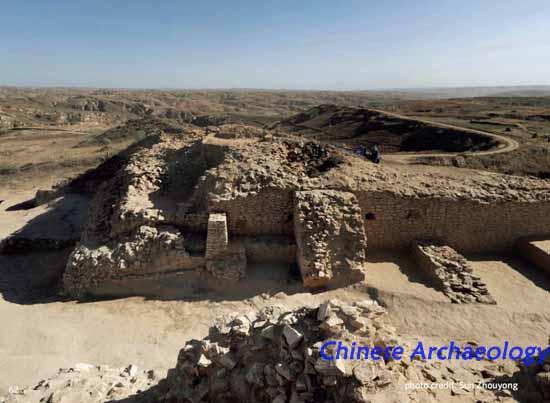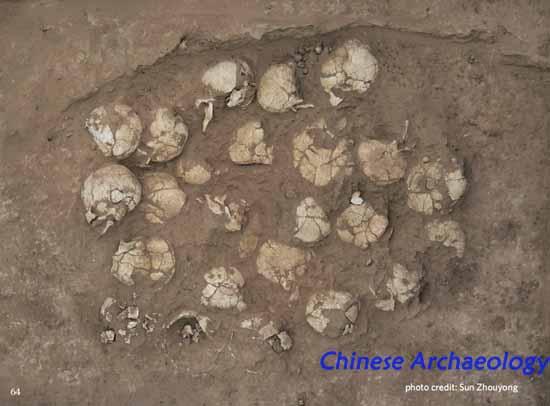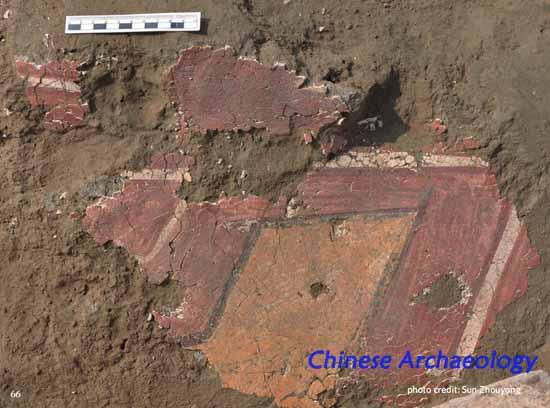Sun Zhouyong / Shaanxi Institute of Archaeology
Source - http://www.kaogu.cn/en/detail.asp?ProductID=4422
The Shimao Site is located in the northern part of the Loess Plateau, and it is on the southern edge of the Mu Us (Ordos) Desert in China. Between 2011 and 2012 when a full coverage survey was carried out by archaeologists from Shaanxi province, three well-preserved stone-made enclosures – the Huang Cheng Tai platform, an inner and outer city – were discovered.
Inside the interior walls are densely distributed residential zones, cemeteries, and craft workshops. All of these findings are dated to the middle and late Longshan culture of late Neolithic and the early Xia period (early Bronze Age), according to radiocarbon dates and excavated artifacts. The Shimao walled site encompasses a total area of 400 hectares.

The stone-walled platform, known to the local villagers as Huang Cheng Tai (Imperial City Platform), is shaped as a pyramid, with the bottom wider than the top. The most well-preserved part of the wall surrounding the platform is over ten stories in height. The top of the platform measures at over eight hectares. It is most likely a district of palatial nature, where large burials, stone figurines and other important features and artifacts have been found. It is encircled by both interior and exterior stone walls that are constructed largely along the ridges of hills, with a NE-SW orientation. These walls measure at 2.5 m wide on average. The most well-preserved section is about 1 m above the current ground surface. The perimeter of interior wall is about 4200 m in length, and the exterior wall, 5700 m. Many defense features, such as gates, watch towers and mamian (a horse face-shaped reinforcement feature for defense) are located along the stone walls. Inside the interior walls are densely distributed residential zones, cemeteries, and craft workshops. Remains of this kind are relatively rare in the outer city.

In 2012, a large-scale excavation was conducted on the east gate of the exterior stone wall, an extensive, complex structure constructed of advanced technology. It is accompanied by defense facilities such as mamian and watch towers. The excavated artifacts include jades (often found inside the stone walls), wall paintings (on the inner surface of interior walls), stone sculptures, pottery, and stone tools. The East Gate of the Exterior Wall is located in the northeast of the outer city, which is comprised of an entranceway, an outer wengcheng walled enclosure, rammed earth platforms, an inner wencheng walled enclosure, gatehouse (menshu), watchtowers (mamian), turret and other components. These structures are connected by an approximately 9 m wide『-shaped doorway and measure at 4000 m2. The East Gate of the Exterior Wall is situated in the most highly elevated area of the site, a prime strategic location. Different stratigraphic layers have been clearly identified and an abundance of cultural remains have been excavated.
On the basis of stratigraphic data and ceramic typological studies, the Shimao site has been dated to around 2000 BCE, between the Longshan period and Xia dynasty. The C-14 dates of 2200-2040 BCE from the renmu wooden beam embedded in the city walls and 1940-1780 BCE from the lime plaster at the housing foundation of F6 both coincide with archaeological findings. The Shimao site is constructed around the middle Longshan period or slightly later (Huang Cheng Tai) and is abandoned by the early Xia Dynasty.

The layout of the walled settlement at Shimao strongly indicates the principles of urban planning in ancient China, with a palatial or imperial complex in the center, surrounded by one or two city walls. Jades are often found inside the stone walls, which is notably unique. The findings provide support for the idea that people at the time may have viewed “jades” as apotropaic. The East Gate may have been related to places like Yumen and Yaotai mentioned in classical texts.
On the walls of the inner wencheng walled enclosure are colorful paintings of geometric shapes, which are highly significant to the study of the History of Chinese ancient art. The technology of the wooden beam (renmu) horizontally placed in the city walls for the purpose of structural reinforcement is a major innovation in engineering and architecture in ancient China. The Wencheng walled enclosure, mamian, watchtowers and other structures, on one hand, indicate that the Northern region may have been often embroiled in intense political turmoil and violent military conflicts, and on the other hand, provide some of the earliest evidence of an earthen and stone-built defense system in East Asia. The many human skulls buried in the lower layer of the city gate suggest that ritual activities took place at the time of construction and there appears to have been increasing social complexity in this area.
Currently, an unmanned aerial vehicle is used to conduct 3D spatial analysis and obtain high-resolution images, and the information acquired will be used for the Digital Orthophoto Map (DOM), Digital Elevation Model (DEM) and ArcGIS of the site. Specialists in physical anthropology, botany, zoology, geology, carbon dating and other disciplines are involved in the research of the Shimao site.
The Shimao site is the largest among many walled settlements dating to around 2000 BC that have been discovered in China. The period around 2000 BC is an era of social, cultural, and political transformation, witnessing the formation of the earliest cities, states, and civilizations in China as well as East Asia. The discovery and excavation of the Shimao walled settlement undoubtedly contributes and may even transform our understanding of the development of early civilizations and the process of state formation in China.
Biographical Sketch
Dr. Sun Zhouyong is a researcher at the Shaanxi Provincial Institute of Archaeology. He received his B.A. (1995) from the Department of Anthropology (Archaeology Division) at Xiamen University, M.A. (2002) from Northwest University (2002), and Ph.D. (2007) from La Trobe University, Melbourne. In 2009 he was a Visiting Scholar at the University of California, Los Angeles (UCLA). He specializes in field archaeology and, over the years, several of the projects he worked on have been acknowledged as “Top Ten Archaeological Finds of China”. His current research focuses on the Neolithic, Shang and Zhou archaeology, and is especially interested in early state formation and the settlement pattern and social structure of Northern China during the Neolithic Period. He has published over 40 articles and 5 books, among which is Craft Production in the Western Zhou Dynasty: A Case Study of a jue-earrings Workshop at the Predynastic Capital Site, Zhouyuan, China (Oxford: Archaeopress, 2008). He has served as the head of three national-level research projects in the past five years. Dr. Sun’s current research is mainly focused on the Shimao archaeological site. The team is multi-disciplinary, involving researchers in archaeology, physical anthropology, botany, zoology, geology, carbon dating and other areas. These scholars are experienced specialists in their respective fields and great strides have been made in their research on the Shimao site.